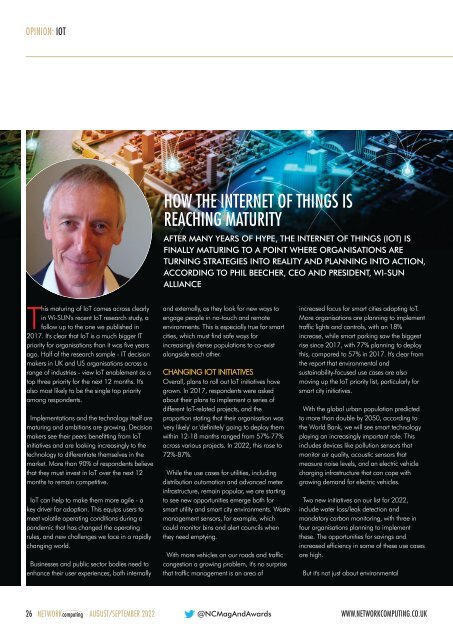NC Sep-Oct 2022
You also want an ePaper? Increase the reach of your titles
YUMPU automatically turns print PDFs into web optimized ePapers that Google loves.
OPINION: IOT<br />
HOW THE INTERNET OF THINGS IS<br />
REACHING MATURITY<br />
AFTER MANY YEARS OF HYPE, THE INTERNET OF THINGS (IOT) IS<br />
FINALLY MATURING TO A POINT WHERE ORGANISATIONS ARE<br />
TURNING STRATEGIES INTO REALITY AND PLANNING INTO ACTION,<br />
ACCORDING TO PHIL BEECHER, CEO AND PRESIDENT, WI-SUN<br />
ALLIA<strong>NC</strong>E<br />
This maturing of IoT comes across clearly<br />
in Wi-SUN's recent IoT research study, a<br />
follow up to the one we published in<br />
2017. It's clear that IoT is a much bigger IT<br />
priority for organisations than it was five years<br />
ago. Half of the research sample - IT decision<br />
makers in UK and US organisations across a<br />
range of industries - view IoT enablement as a<br />
top three priority for the next 12 months. It's<br />
also most likely to be the single top priority<br />
among respondents.<br />
Implementations and the technology itself are<br />
maturing and ambitions are growing. Decision<br />
makers see their peers benefitting from IoT<br />
initiatives and are looking increasingly to the<br />
technology to differentiate themselves in the<br />
market. More than 90% of respondents believe<br />
that they must invest in IoT over the next 12<br />
months to remain competitive.<br />
IoT can help to make them more agile - a<br />
key driver for adoption. This equips users to<br />
meet volatile operating conditions during a<br />
pandemic that has changed the operating<br />
rules, and new challenges we face in a rapidly<br />
changing world.<br />
Businesses and public sector bodies need to<br />
enhance their user experiences, both internally<br />
and externally, as they look for new ways to<br />
engage people in no-touch and remote<br />
environments. This is especially true for smart<br />
cities, which must find safe ways for<br />
increasingly dense populations to co-exist<br />
alongside each other.<br />
CHANGING IOT INITIATIVES<br />
Overall, plans to roll out IoT initiatives have<br />
grown. In 2017, respondents were asked<br />
about their plans to implement a series of<br />
different IoT-related projects, and the<br />
proportion stating that their organisation was<br />
'very likely' or 'definitely' going to deploy them<br />
within 12-18 months ranged from 57%-77%<br />
across various projects. In <strong>2022</strong>, this rose to<br />
72%-87%.<br />
While the use cases for utilities, including<br />
distribution automation and advanced meter<br />
infrastructure, remain popular, we are starting<br />
to see new opportunities emerge both for<br />
smart utility and smart city environments. Waste<br />
management sensors, for example, which<br />
could monitor bins and alert councils when<br />
they need emptying.<br />
With more vehicles on our roads and traffic<br />
congestion a growing problem, it's no surprise<br />
that traffic management is an area of<br />
increased focus for smart cities adopting IoT.<br />
More organisations are planning to implement<br />
traffic lights and controls, with an 18%<br />
increase, while smart parking saw the biggest<br />
rise since 2017, with 77% planning to deploy<br />
this, compared to 57% in 2017. It's clear from<br />
the report that environmental and<br />
sustainability-focused use cases are also<br />
moving up the IoT priority list, particularly for<br />
smart city initiatives.<br />
With the global urban population predicted<br />
to more than double by 2050, according to<br />
the World Bank, we will see smart technology<br />
playing an increasingly important role. This<br />
includes devices like pollution sensors that<br />
monitor air quality, acoustic sensors that<br />
measure noise levels, and an electric vehicle<br />
charging infrastructure that can cope with<br />
growing demand for electric vehicles.<br />
Two new initiatives on our list for <strong>2022</strong>,<br />
include water loss/leak detection and<br />
mandatory carbon monitoring, with three in<br />
four organisations planning to implement<br />
these. The opportunities for savings and<br />
increased efficiency in some of these use cases<br />
are high.<br />
But it's not just about environmental<br />
26 NETWORKcomputing AUGUST/SEPTEMBER <strong>2022</strong> @<strong>NC</strong>MagAndAwards<br />
WWW.NETWORKCOMPUTING.CO.UK

















